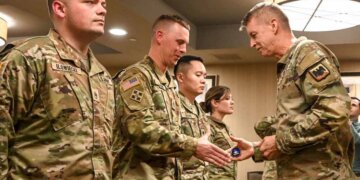by Andrea Downing Peck
January’s roll out of the Blended Retirement System (BRS) starts the clock ticking for many service members on one of the biggest financial decisions they will make — deciding whether to remain in the military’s defined benefit pension system or opt in to the new revamped retirement plan.
Decisions, decisions.
Historically, only 17% of active duty service members complete 20 years of service and qualify for today’s “High 3” retirement system, which pays retirees an annual amount equal to 50% of their highest 36 months of basic pay, plus cost-of-living adjustments in retirement. The BRS eliminates the “golden handcuffs” of the military’s traditional all-ornothing retirement system and substitutes matching and automatic government contributions to service members’ Thrift Savings Plans (TSP). Going forward, an estimated 85% of veterans will walk away from military service with retirement savings. Those who stay in 20 years or longer under the BRS will continue to receive a traditional military pension, but a lower “years of service multiplier” will reduce the annuity amount to 40% of basic pay. BRS retirees also will have the option to receive a portion of their retirement in a lump sum.
Navy veteran Doug Nordman, author of “The Military Guide to Financial Independence & Retirement” and founder of The-Military-Guide.com, points out the BRS is designed to benefit service members who hang up their uniforms before qualifying for a pension.
“Now, instead of hanging on for 20 years, everyone can earn matching contributions to their TSP accounts and leave after serving their obligation,” he says. “More money means more choices.
“Stay on active duty as long as it’s challenging and fulfilling,” Nordman adds. “But when the fun stops, it’s time to consider the Reserves, National Guard or even separation. The BRS, with matching contributions in the TSP, makes that a much better financial option.”
All currently serving military members are grandfathered into the High 3 retirement system, but mid-career and younger service members will have the choice to enroll in the BRS, making a one-time irrevocable decision. Josh Andrews, a Certified Financial Planner with USAA and Air Force Reserve officer, suggests service members look carefully at the trajectory of their careers when deciding whether to remain in the High 3.
“If you’re at the 10- or 11-year point and in an undermanned career field, your chances of being reduced [in force] or kicked out are low. Maybe you’ve had very good performance reports and made rank before your peers — all showing you have a very good chance of making it to 20 years — then you might want to consider staying in the High 3,” Andrews says. “When you look at the plans side-by-side, in almost all cases, the High 3 is better than the BRS for the person that retires. It is a very good deal. But for a person starting out or at the end of their first term, there is so much time ahead of them when things could change. It’s a big bet when placing it all on the High 3 and making it to 20 years.”
Here are answers to 10 BRS questions:
1. Who’s eligible?
You get to choose between the BRS and the High 3 plan if you have less than 12 years of service. (You joined the military after Dec. 31, 2005.) Anyone who joined the military before Jan. 1, 2006, will remain in the current retirement system. Anyone joining as of Jan. 1, 2018, is automatically enrolled in the BRS.
2. Is eligibility different for the National Guard and Reserve?
National Guard and Reserve members are eligible to opt in if they are in active or drilling service, and on pay status, as Dec. 31, 2017, and have fewer than 4,320 retirement points. Eligibility is not affected by the number of service or qualifying years accumulated. The BRS does not change when a National Guard or Reserve member is eligible to retire, and National Guard and Reserve members who opt-in remain eligible to receive their retired pay earlier than age 60 if have credited active service.
3. What happens to those who opt out?
Nothing changes for service members who choose to remain in the legacy High 3 retirement system, which will provide them with lifetime retired pay upon completing 20 years of service. The High 3 annuity calculation for these service members will remain: 2.5% x years served x average of highest 36 months of basic pay.
4. Under the BRS, how much will the DoD contribute to a service member’s TSP?
Unlike most private companies, the DoD formula is not a straight one for-one match. Instead, the DoD automatically will contribute an amount equal to 1% of a member’s basic pay after completion of 60 days of service and will offer matching contributions at the start of year three through the completion of 26 years of service. A service member who contributes up to 3% of their basic pay will see their contributions matched in full while a 4% contribution will receive a 3.5% DoD match and 5% contribution will receive a 4% DoD match. Nordman points out the BRS’s defined contribution plan puts “the responsibility for saving for retirement squarely on the shoulders of the service member.” He believes it’s “absolutely essential” for service members to maximize the DoD match by contributing at least 5% of their base pay to their traditional TSP or Roth TSP accounts rather than miss out on “free money and years of compounding.”
5. Are service members entitled to all their DoD matching and automatic contributions?
Service members who opt in to the BRS are immediately “vested,” meaning they own all their contributions and 100% of DoD matching contributions and earnings. Automatic government contributions and accrued earnings from those contributions, however, are forfeited if a member separates prior to completing two years of service.
6. Is a 20-year military career still an attractive option?
As an incentive to remain in the military, the BRS includes Continuation Pay, a cash payout, at the mid-career point to service members who commit to serving an additional three years or more. While service members who retire under the BRS will receive a smaller pension (2% of their High 3 basic pay x years of service), they will continue to receive 1% automatic government contributions and matching contributions to their TSP through 26 years of service.
7. What is the BRS’s lumpsum retirement option?
The BRS will offer retired service members the option of a cash buyout in exchange for reducing their monthly retirement checks until “full retirement age” (age 67 for active duty retirees and age 60 for most reservists and Guard members).
8. Is the lump-sum option a good deal?
When taking a lump sum, a retiree forfeits a portion of their working-age retirement pay (either 25% or 50% of the monthly benefit) in exchange for a single lump sum payment or four equal annual installments. While receiving a sixfigure payout could be enticing, the lump sum will be calculated using the “Government Discount Rate,” an inflation-adjusted annual rate — currently 6.99% — that works in the government’s favor. “A comparable discount rate in a civilian corporation would be 2.99%,” Andrews explains. “The discount rate the DoD is using is very high. If you take a lump sum, you are guaranteed less money in your pocket over time.”
Nonetheless, Andrews says, taking a lump sum might be a smart move for someone facing foreclosure or other extreme financial hardship. Andrews also notes the financial cost of taking a lump sum would be would be less for Reserve and National Guard members who typically begin receiving military retired pay at age 60, and, therefore, would forfeit full retired pay for only seven years.
9. Eligible service members have until Dec. 31, 2018, to opt in. Why decide in January?
“I would like people to do their research and get educated now so they know what their decision is going to be,” Andrews says. “If you’re going to elect to go into the BRS, you need to do that as early in the year as possible so you start getting automatic and matching contributions right away. But if you are unsure what you want to do, don’t rush into it because you think you are missing out and make the wrong decision.”
10. Where can I go for more information?
National Guard Blended Retirement Resource Page: www.nationalguard.mil/Features/brs/
DOD: http://militarypay.defense.gov/BlendedRetirement/
Read comments






































